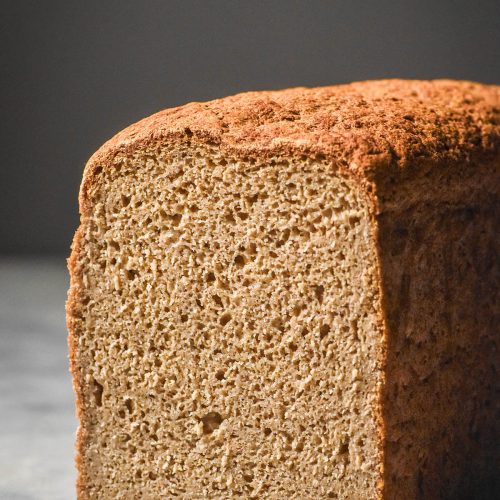
Teff bread (gluten free, vegan)
*Tablespoons are in Australian tablespoons. Use ml for international accuracy.
Equipment
- small USA pan Pullman pan – 23cm length X 10cm width X 10cm height (9 X 4 X 4 inches)
Ingredients
- 500 g white teff flour
- 100 g tapioca flour or cassava flour
- 25 g psyllium husk powder
- 10-12 g salt
- 1 X 7.5g sachet instant yeast
- 40 ml (2 tablespoons)* maple syrup (8 American teaspoons)
- 20 ml (1 tablespoon)* oil (4 American teaspoons)
- 750-850 g water
Instructions
- Grease and line your small USA pan Pullman pan – 23cm length X 10cm width X 10cm height (9 X 4 X 4 inches). I like to line my tin so that there are baking paper handles to lift the bread out at the end of baking.
- Combine the dry ingredients in a large mixing bowl and whisk thoroughly.
- Add the wet ingredients and whisk thoroughly until completely combined.
- When freshly whisked, your dough should look and feel like a thin, aerated batter. It should feel light under the whisk and have little air bubbles on the surface. I would describe it as a thin batter with baking soda that just had an acid added - that sort of light and aerated. If your dough is significantly thicker than this immediately after whisking, add more water until you reach this consistency. Hydration is hugely dependent on your individual flours, so you need to use your intuition as opposed to following a recipe without assessing your own dough. See the body of the post for a more in depth description of what you are looking for.
- Cover the bowl and allow to proof for 1 hour. After the first proof, the dough should be firm with bubbles on top. Depending on how much liquid you added, you should be able to pick it up in a ball, even if it is soft and floppy. If you break the dough apart with your hands, it should feel nice and bubbly.
- Transfer the dough into your lined Pullman pan and use a moistened hand to smooth down the top. Cover the tin with a tight fitting cover that won’t touch the loaf (I use an inverted produce bag) and allow to proof for an additional 1-2 hours (season dependent, see notes in body of post) until domed on top.
- Preheat the oven to max temperature about 30-40 minutes before your loaf is ready to bake.
- Your loaf is proofed when it domes nicely (but not too dramatically) over the top of the Pullman pan. The more liquid you add and the hotter your kitchen, the quicker your loaf will proof (see notes in body of post).
- Place the loaf in the oven and turn the heat down to 220C/430F. Bake for 20 minutes, then turn the heat down to 200C/400F and bake for an additional 30-40 minutes. The top of the loaf should be golden brown and firm to the touch.
- Remove the loaf from the oven and allow to cool for 20 minutes before carefully removing from the tin and transferring to a cooling rack. Allow to cool completely before slicing. Leftover slices keep well in an airtight container in the fridge and can also be frozen and defrosted (but are best as toast after defrosting).
Notes
- Note that this bread necessarily produces quite moist feeling slices. The liquid content is necessary to properly hydrate the teff flour and to produce a flexible, elastic and soft crumb as opposed to a cakey crumb. If you don't love wetter feeling slices of bread, this recipe might not be for you.
- There is such a thing as too much liquid, though, so see the troubleshooting section if you feel your bread is too wet.
- Hydration is highly dependent on your individual flours. Read through the notes and troubleshooting in the post. I find that cassava flour is more absorbent than tapioca flour, so you might need to tinker if you use cassava flour.
- See the notes in the body of the post for anything you could ever want to know about this loaf.
- As soon as I test dark teff flour I will update the post.
- Most international teaspoons are 5ml and tablespoons are 15ml. Australia (where I live) uses 5ml teaspoons, but our tablespoons are 20ml. This is why I offer American teaspoon measures - they offer the moist straightforward conversion ml wise.
Tried this recipe?Let us know how it was!